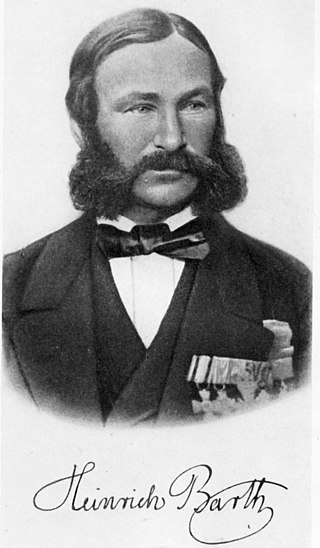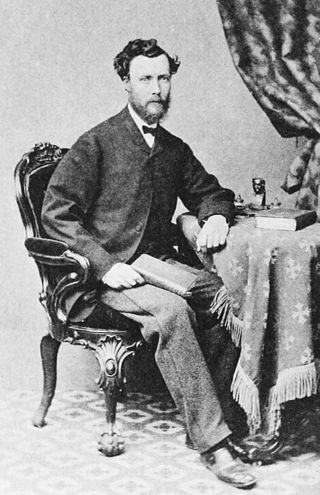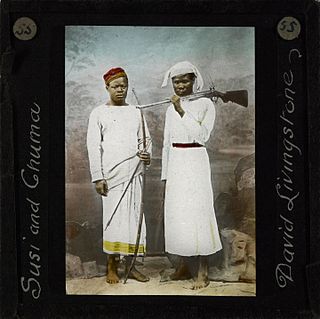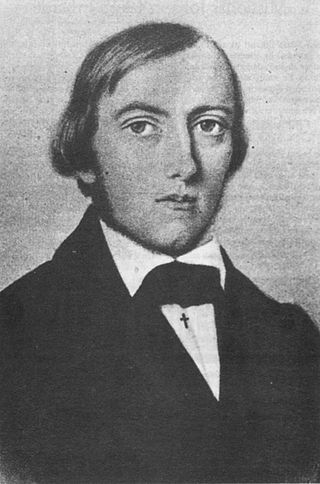
David Livingstone was a Scottish physician, Congregationalist, pioneer Christian missionary with the London Missionary Society, and an explorer in Africa. Livingstone was married to Mary Moffat Livingstone, from the prominent 18th-century Moffatt missionary family. Livingstone came to have a mythic status that operated on a number of interconnected levels: Protestant missionary martyr, working-class "rags-to-riches" inspirational story, scientific investigator and explorer, imperial reformer, anti-slavery crusader, and advocate of British commercial and colonial expansion. As a result, Livingstone became one of the most popular British heroes of the late 19th-century Victorian era.

Johann Heinrich Barth was a German explorer of Africa and scholar.

Lieutenant Colonel Sir Francis Edward Younghusband, was a British Army officer, explorer and spiritual writer. He is remembered for his travels in the Far East and Central Asia; especially the 1904 British expedition to Tibet, led by himself, and for his writings on Asia and foreign policy. Younghusband held positions including British commissioner to Tibet and president of the Royal Geographical Society.

German New Guinea consisted of the northeastern part of the island of New Guinea and several nearby island groups and was the first part of the German colonial empire. The mainland part of the territory, called Kaiser-Wilhelmsland, became a German protectorate in 1884. Other island groups were added subsequently. The Bismarck Archipelago, and the North Solomon Islands were declared a German protectorate in 1885. The Caroline Islands, Palau, and the Mariana Islands were bought from Spain in 1899. German New Guinea annexed the formerly separate German Protectorate of Marshall Islands, which also included Nauru, in 1906. German Samoa, though part of the German colonial empire, was not part of German New Guinea.

Johann Ludwig Krapf was a German missionary in East Africa, as well as an explorer, linguist, and traveler. Krapf played an important role in exploring East Africa with Johannes Rebmann. They were the first Europeans to see Mount Kenya with the help of Akamba who dwelled at its slopes and Kilimanjaro. Ludwig Krapf visited Ukambani, the homeland of the Kamba people, in 1849 and again in 1850. He successfully translated the New Testament to the Kamba language. Krapf also played a key role in exploring the East African coastline, especially in Mombasa.

Joseph Thomson was a Scottish geologist and explorer who played an important part in the Scramble for Africa. Thomson's gazelle and Thomson's Falls, Nyahururu, are named after him. Excelling as an explorer rather than an exact scientist, he avoided confrontations among his porters or with indigenous peoples, neither killing any native nor losing any of his men to violence. His motto is often quoted to be "He who goes gently, goes safely; he who goes safely, goes far."

The Cambridge Seven were six students from Cambridge University and one from the Royal Military Academy, who in 1885, decided to become missionaries to China through the China Inland Mission. The seven were:

Sir John Kirk was a British physician, naturalist, companion to explorer David Livingstone, and a British administrator in Zanzibar, East Africa, where he was instrumental in ending the slave trade in that country, with the aid of his political assistant, Ali bin Saleh bin Nasser Al-Shaiban, and Alexander Mackay, a missionary in Zanzibar.
The Church Mission Society (CMS), formerly known as the Church Missionary Society, is a British Anglican mission society working with Christians around the world. Founded in 1799, CMS has attracted over nine thousand men and women to serve as mission partners during its 200-year history. The society has also given its name "CMS" to a number of daughter organisations around the world, including Australia and New Zealand, which have now become independent.

George Grenfell (21 August 1849, in Sancreed, Cornwall – 1 July 1906, in Basoko, Congo Free State was a Cornish missionary and explorer.

Johannes Rebmann, also sometimes anglicised as John Rebman, was a German missionary, linguist, and explorer credited with feats including being the first European, along with his colleague Johann Ludwig Krapf, to enter Africa from the Indian Ocean coast. In addition, he was the first European to find Kilimanjaro. News of Rebmann's discovery was published in the Church Missionary Intelligencer in May 1849, but disregarded as mere fantasy for the next twelve years. The Geographical Society of London held that snow could not possibly occur let alone persist in such latitudes and considered the report to be the hallucination of a malaria-stricken missionary. It was only in 1861 that researchers began their efforts to measure Kilimanjaro. Expeditions to Tanganyika between 1861 and 1865, led by the German Baron Karl Klaus von der Decken, confirmed Rebmann's report. Together with his colleague Johann Ludwig Krapf they were also the first Europeans to visit and report Mount Kenya. Their work there is also thought to have had effects on future African expeditions by Europeans, including the exploits of Sir Richard Burton, John Hanning Speke, and David Livingstone.

James Chuma and Abdullah Susi were people from central Africa who took part in the second Zambesi expedition led by the explorer David Livingstone, and were employed by him in his last expedition. They had significant roles in organisation, and were the first to greet Stanley when his search party made contact.

Allen Francis Gardiner was a British missionary and Royal Navy officer.

Mount Namuli is the second highest mountain in Mozambique and the highest in the Province of Zambezia. It is 2,420 m (7,940 ft) high and was measured, surveyed and described in 1886 by Henry Edward O'Neill, the British consul in Mozambique. The Namuli massif consists of a level plateau with the granite dome of Mount Namuli above. The area was historically clad in tropical rainforest and is an important biodiversity hotspot with many endemic species of animals and plants. The lower slopes are now mainly used for the cultivation of tea and the middle slopes for other agricultural purposes, with indigenous forest now mostly restricted to the higher parts and corridors along water courses.
James Frederic Elton (1840–1877) was an English explorer in Africa.

Henry Aaron Stern was an Anglican missionary and captive in Abyssinia.
Karl Wilhelm Isenberg, spelt or known by names Carl Wilhelm Isenberg or Charles William Isenberg or C. W. Isenberg or Carl W. Isenberg or Charles Isenberg, was a German Church Missionary Society missionary and linguist to East Africa and Western India.

Johann Jakob Erhardt, or John James Erhardt, was a German missionary and explorer who worked in East Africa and India. Although he remained on or near the coast of East Africa, he contributed to European knowledge of the interior through gathering descriptions from local people who had traveled there. His map of the region stimulated dispatch of the expedition of Burton and Speke.
Lake Uniamési or the Uniamesi Sea was the name given by missionaries in the 1840s and 1850s to a huge lake or inland sea they supposed to lie within a region of Central East Africa with the same name.

The British explorer and Arabist Sir Richard Francis Burton (1821–1890) published over 40 books and countless articles, monographs and letters. Most of Burton's books are travel narratives or translations. His only works of original imaginative fiction are both in verse: Stone Talk (1865) and the well-known The Kasidah (1880), both of which he published under the pseudonym "Frank Baker".















